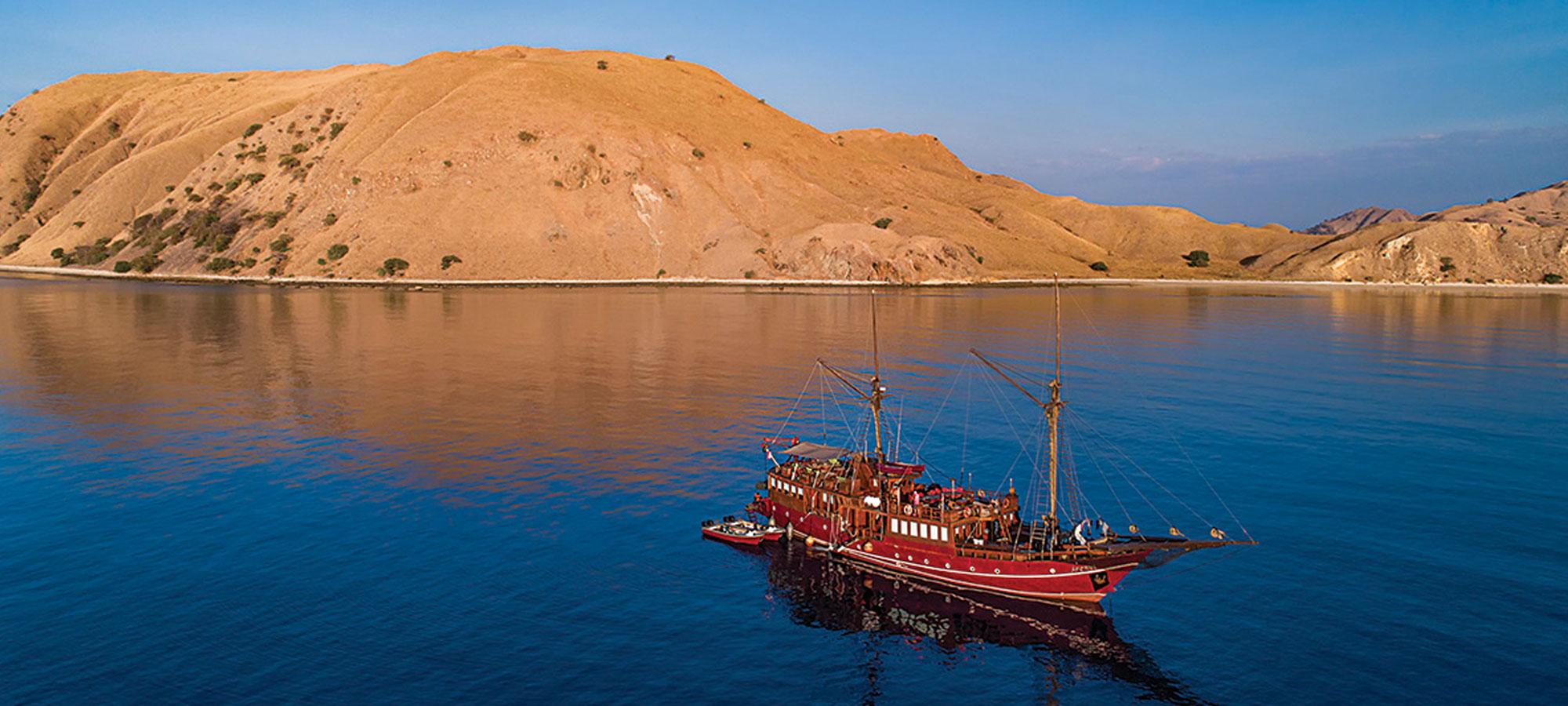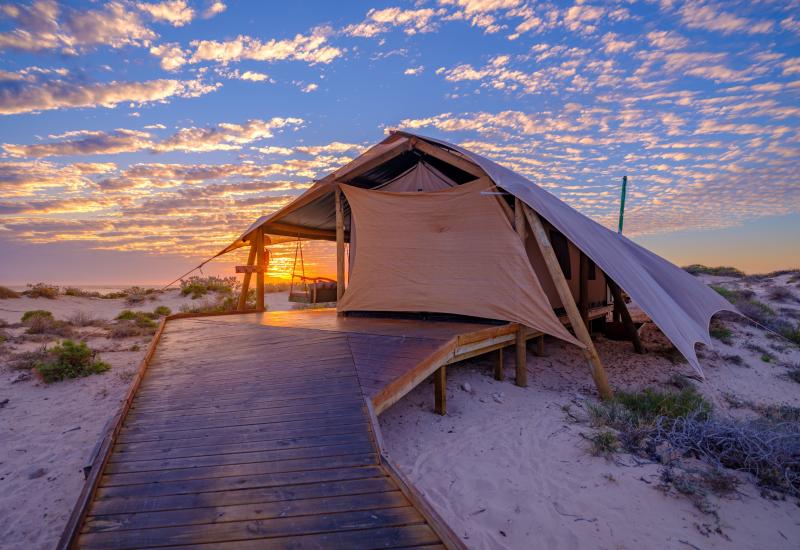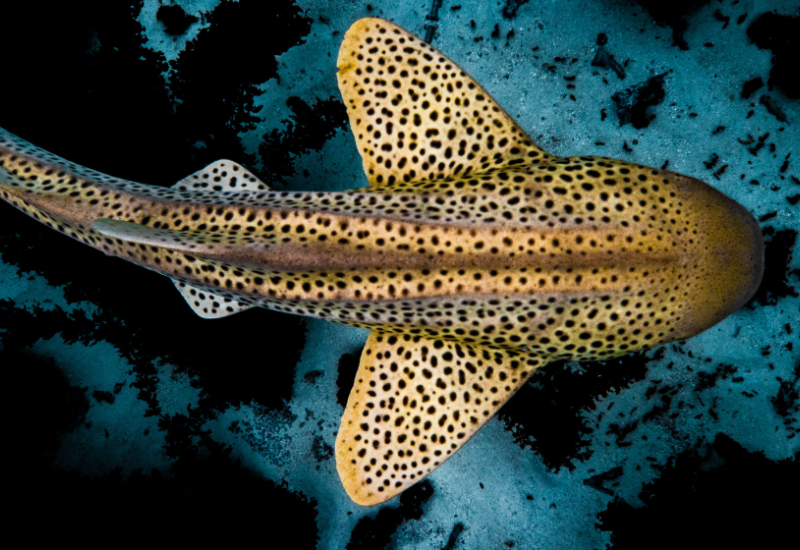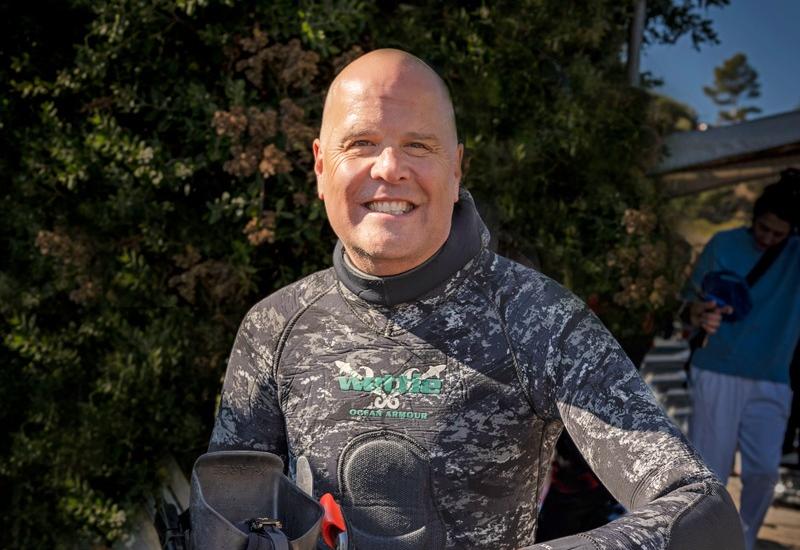How I Learned to Love the Current and Wild Brilliance of Komodo National Park
A WORD OF ADVICE: NEVER SEARCH YOUR SYMPTOMS ON WEBMD WHEN YOU’RE FEELING A LITTLE OFF.
In just a few keystrokes, you can go from the sniffles to smallpox and three weeks to live.
Yet here I am, staring bleary-eyed at my phone, committing the equivalent crime in the dive world. I Google Is Komodo safe for diving? and scroll past a few pages to find a host of message-board entries. It’s a silly query from a diver who knows better, but for some reason this area of Indonesia has always carried a rep.
My eyes widen as I see tales of current ripping the masks off unsuspecting divers (Do I have dengue fever?), channels sweeping people up and spitting them out far from sight (Maybe it’s the swine flu?) and unexpected down-currents sending folks to the depths without warning (Looks like it’s scurvy.)
Gulp. I’m confident in my skills, but after this search I feel like a hypochondriac. Luckily, I know a good doctor—or the Komodo equivalent.
Guillermo Alcover and Lisa Herding have guided thousands of dives in Komodo National Park. They can navigate these sites as well as anyone, but it’s kind of like parenting a 12-year-old: You know them really well, but they’re changing every day, and they sure are temperamental.
“When you dive here, you need to make sure the people you go with know the area,” says Alcover, who has been diving Komodo since 2011 along with Herding. “When guests come to us and say, ‘We don’t want to dive Komodo because of the current,’ we tell them, ‘Do one trip with us. You will see the difference.’”
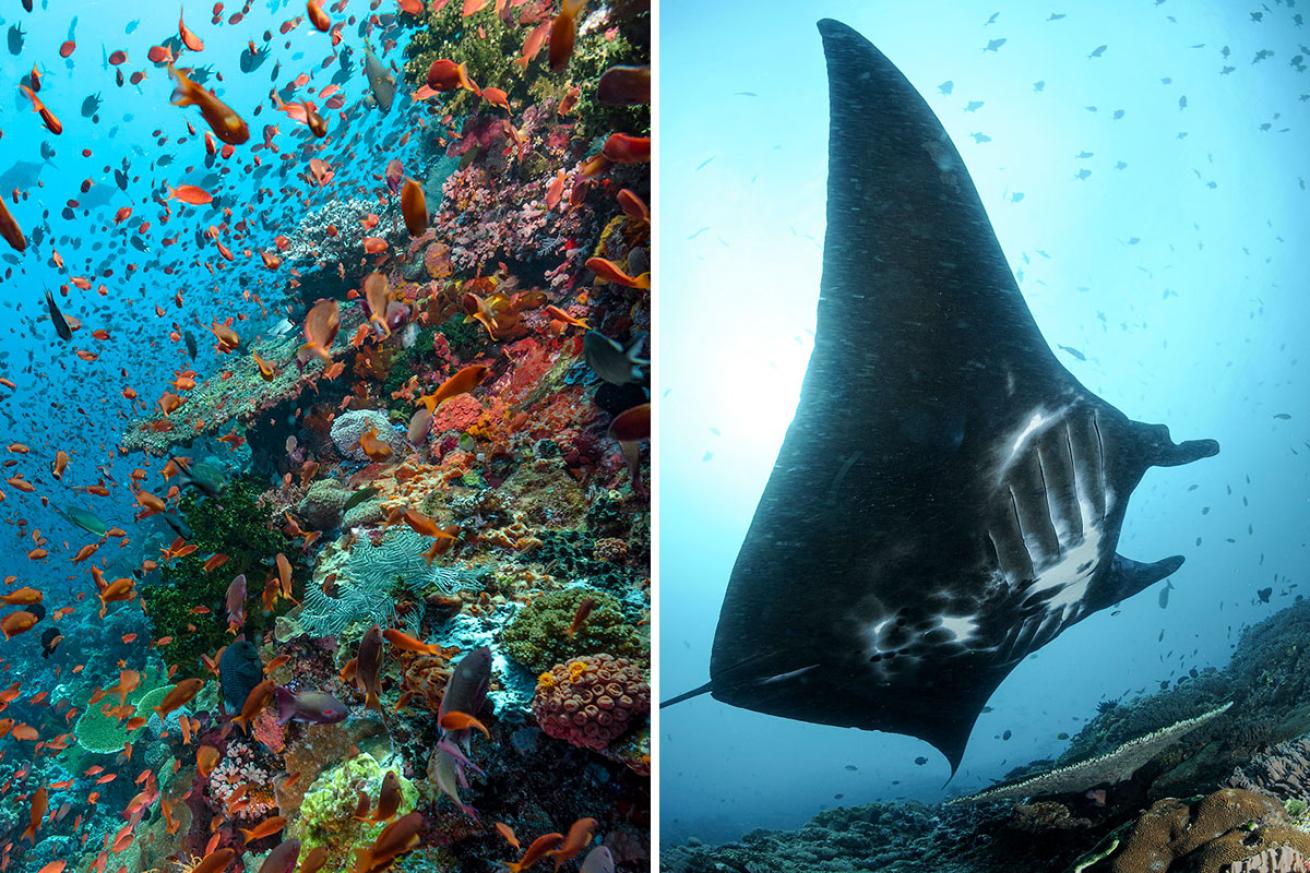
Fabien Michenet/Beth WatsonA chaotic mass of tropical fish — especially anthias—helps make Komodo diving a thrill; passing mantas delight divers of all levels.
THE LITTLE WAVE
Poll the passengers aboard any Arenui excursion and you’ll find the vessel itself is one of the main attractions. Some divers would sign up for a harbor tour as long as they could spend time on this ship.
Approaching Arenui’s Bali mooring on a dinghy, we round a corner to find the classic phinisi-style vessel shining like a diamond. Managing director Luigi Russo joins us on board to give a quick tour of the 140- foot liveaboard. He explains that local craftsmen built the ironwood hull in South Sulawesi; local people in Java and Bali completed the remaining structure using 13 different types of wood.
Russo has pinpointed three of the most common complaints he’s heard about liveaboard travel—cramped cabins, stuffy shared bathrooms and uncomfortable entries and exits—and turned them upside down with Arenui. He’s a firm believer in quality over quantity, and it shows in the craftsmanship of the boat, the service on board and the safety-minded dive operation.
Arenui is a luxury vessel that caters to the needs of North American divers—aka plenty of air conditioning and a wide range of food options—but is truly in touch with its Indonesian roots. The teakwood used on much of the boat can trace its history back a century. You see the lines where the softer part of the wood has receded and the hard parts remain, something Russo proudly calls “character.”
“With traditional yachts, the designers try to go with a very sleek, polished, refined design,” he says. “But there is a lot of character in the organic, dry finishing. We did not finish it in a modern way because we believe that the character, the spirit of Indonesia, is reflected in the organic finish.”
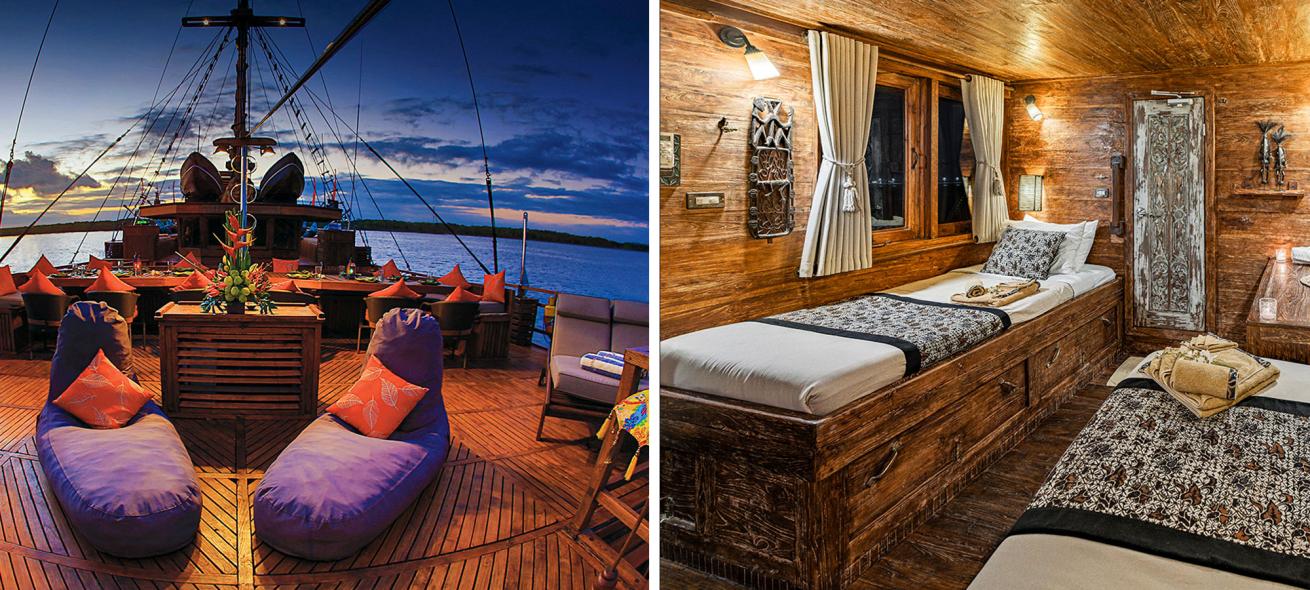
Courtesy The ArenuiArenui's sky deck offers unbeatable views in a comfortable setting; the wood in Arenui's cabins is strong in "character."
Russo started out working on interior design and construction in Italy, where using reclaimed materials is seen as a virtue, a maximization of the spirit in a piece of wood.
This view was not shared in Indonesia circa 2007, where shiny yachts were seen as luxurious and traditional wooden vessels were viewed as cheap. He and his team constantly fielded doubts from local managers: “Are you sure you want to do this?”
If he left the work site, carpenters would start polishing the wood to give it a sleek effect. But Russo held firm to his vision.
“In Ambon at the very beginning of the operation, the local harbor master inspector asked our cruise director: ‘Your boat must have no money, right? Be- cause you didn’t finish the boat,’” Russo recalls with a laugh. “For them, the style looks like it’s half done. The inspector went on to say, ‘I hope you can get enough money to do some nice painting so you can finally finish the boat.’”
A decade later, Russo’s vision still holds up. Many guests are first-time liveaboard divers—people who might be used to diving from resorts and are skeptical of the bunk beds and shared-toilet lifestyle on other boats. The rooms are classy and cozy while offering plenty of storage. Divers are divided into groups, allowing for ample room on deck to spread out and gear up in peace before going out with fewer than four divers to a guide.
"We did not finish it in a modern way because we believe that the character, the spirit of Indonesia, is reflected in the organic finish."
An all-wooden boat does present difficulties. Arenui goes through an extensive—and expensive— dry-docking process once a year, where much of the wood is refinished or replaced. This gives the team the chance to make improvements to cabins and common areas, if needed. This is also why our expedition begins in Bali, where the vessel was docked before heading back to Komodo to start the season.
We make the 150-mile journey east to our first dive at Moyo Island, ready to get in the water but in no hurry to leave our luxurious floating digs.
THE GIFT THAT KEEPS ON GIVING
While the design of the ship will take your breath away—I never get over the detail in the carving on the stairs leading to my cabin that depicts the Hindu Ramayana epic poem—but the service is what will stick with you long after departure.
After one simple order, my first step in the dining room each morning coincides with an eager “Latte?” The food—five meals a day, including a diverse lunch buffet, several entrée options for dinner served individually and absolutely addicting butter cookies always on hand—is second to none. But it’s the dive service that makes this liveaboard accessible for divers of various skill levels and ages.
You forget all about any reservation you may have had about up-currents, washing machines, the leviathan, whatever.
With small groups and extremely competent guides, the staff of Arenui makes every diver feel completely comfortable and shines a spotlight on what’s important: the world-class dive sites. And, oh, is the diving good.
The channel that contains all of Komodo’s dive sites stretches just 35 miles from north to south, bringing warm water down from the Flores Sea and colder water up from the nutrient-rich Indian Ocean. This convergence makes for a Whitman’s Sampler of everything divers love about Indonesia. Over 20 dives, I stuff my log with exclamation points, stars and loads of bucket-list items ticked.
A Guide to Indonesia Scuba Diving**
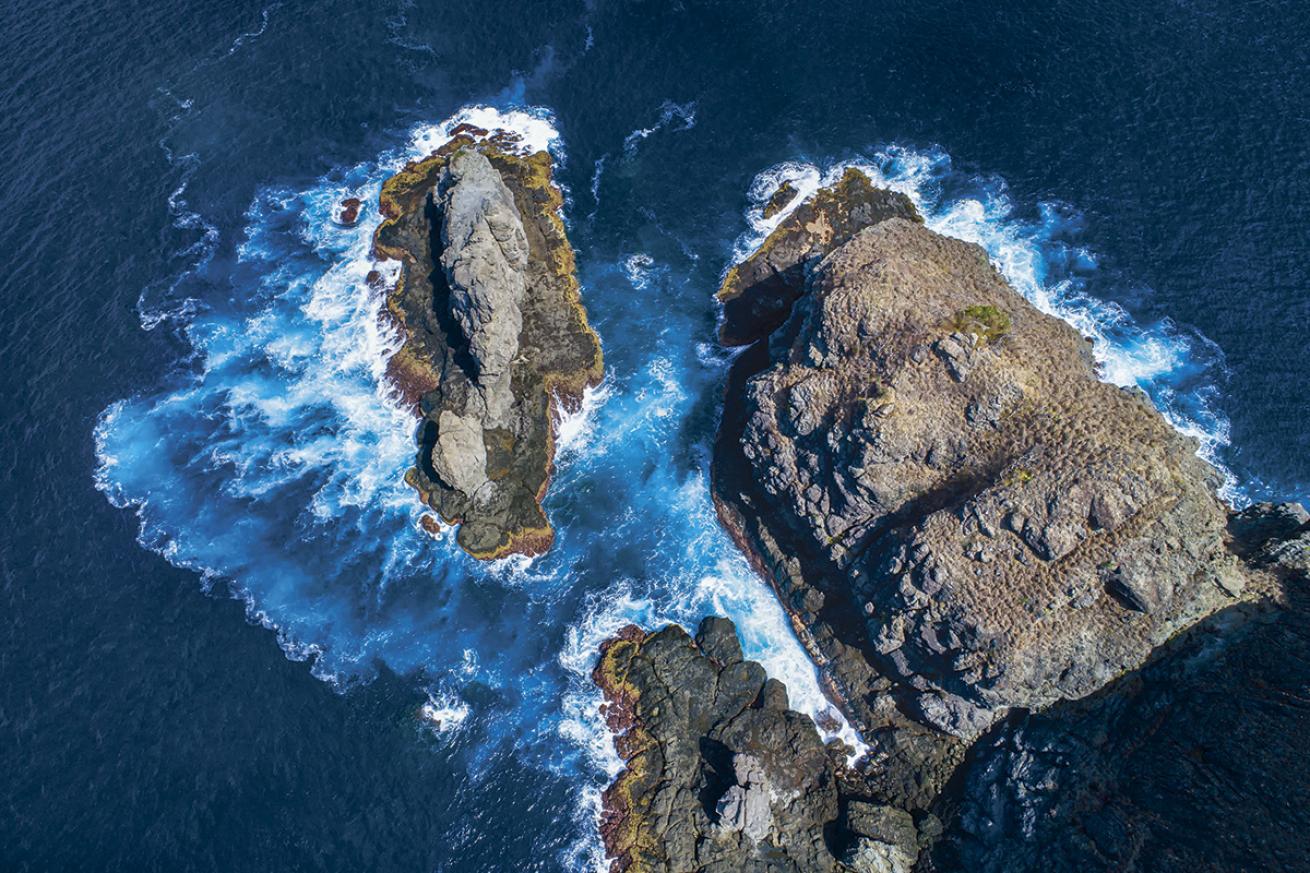
Beth WatsonLife collects at Komodo's current-swept pinnacles.
I watch in awe as a manta soars by at Taka Makassar (aka the Air Strip), flapping its massive fins, stretching 20 feet across, in slow motion against the current. I stare in disbelief as Herding points out the tiniest pygmy seahorse at Black Diamond, a black- sand macro site in the shadow of an active volcano on Sangeang Island.
I encounter hawksbill and green sea turtles munching on bits of sponge, bamboo sharks weaving through buzzing coral reefs, anemonefish bravely defending their home, a field of staghorn coral stretching as far as the 80-foot viz would allow and hundreds of flowerpot coral polyps opening and closing in unison.
Each successful dive is a direct result of Herding’s experience and know-how. Every dive is conducted from one of Arenui’s two fiberglass dinghies. As we reach each site, she slips into the water with mask and freediving fins, diving down to read the current and find the exact location we need to drop. She nails it time after time, planning the entries perfectly to limit fighting against current or running into trouble. Any time we make a negative entry, it’s a straight shot to our target, and we enjoy epic dives at Crystal Rock and Castle Rock, where we deploy hooks and hang with the reef sharks and massive spadefish patrolling the area.
“Without the current, we don’t have all these amazing experiences.”
“Komodo in particular has the most variation of any location we visit,” Herding says. “You can find any weird critter, and at the same time you can see sharks; you can see manta rays; you have blue water; you have soft coral; and you have hard coral.”
I realize that, with the right expertise, current isn’t a symptom of some horrible disease. It’s a blessing.
“Without the current, we don’t have all these amazing experiences,” Herding says. “Diving in Komodo can never get old. I never get bored of these dives.”
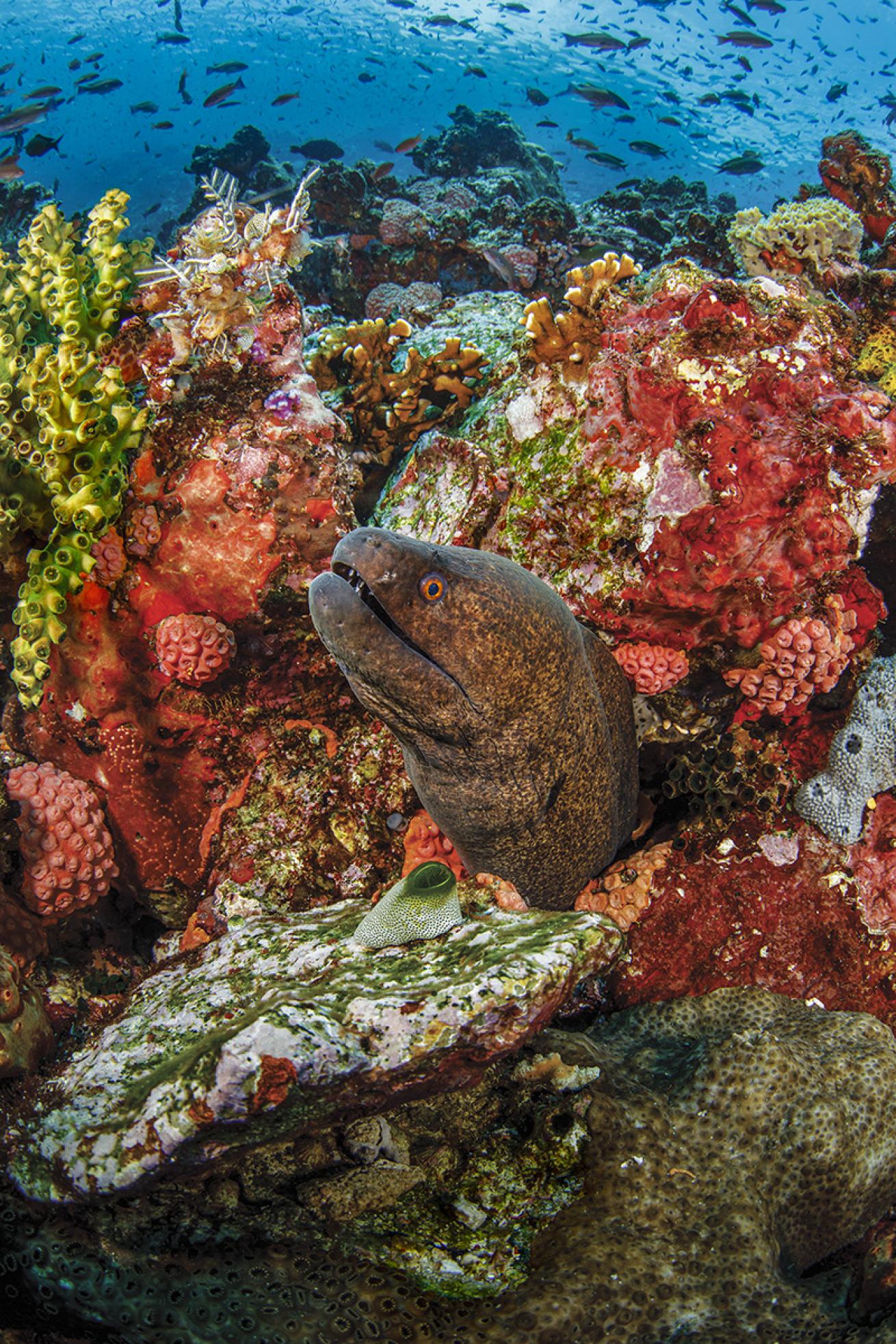
Jennifer PennerA moray eel in a vibrant reef.
DIVERS GUIDE
When to Go: Arenui visits Komodo from May to early October, the Forgotten Islands in April and November, Raja Ampat from December through April and Alor in May and October to maximize the peak season in each region.
Dive Conditions: Divers should feel comfortable controlling their buoyancy in current and deploying an SMB. A full Komodo itinerary includes dives in north and central Komodo, where the temperature averages 84 degrees F and visibility ranges from 40 to 100 feet, and in south Komodo, where the average temperature drops about 5 degrees.
Recommended Training: Drift Diver
Operator: The Arenui is a 140-foot vessel with a 30-foot beam. A staff of 23 serves a max of 16 guests, with eight cabins that include a private head, shower and climate control. The boat has three main decks, including a spacious sky lounge. Guests are offered one complimentary 30-minute massage on board. Arenui runs on a Mitsubishi marine 10-cylinder 440 hp engine common in Indonesia. This is a strategic choice so it can be fixed in remote areas should problems arise; no trips have been canceled due to engine issues in a decade.
Price Tag: An eight-night 2020 Komodo excursion starts at $5,200. Park, port, fuel and nitrox fees are not included.

